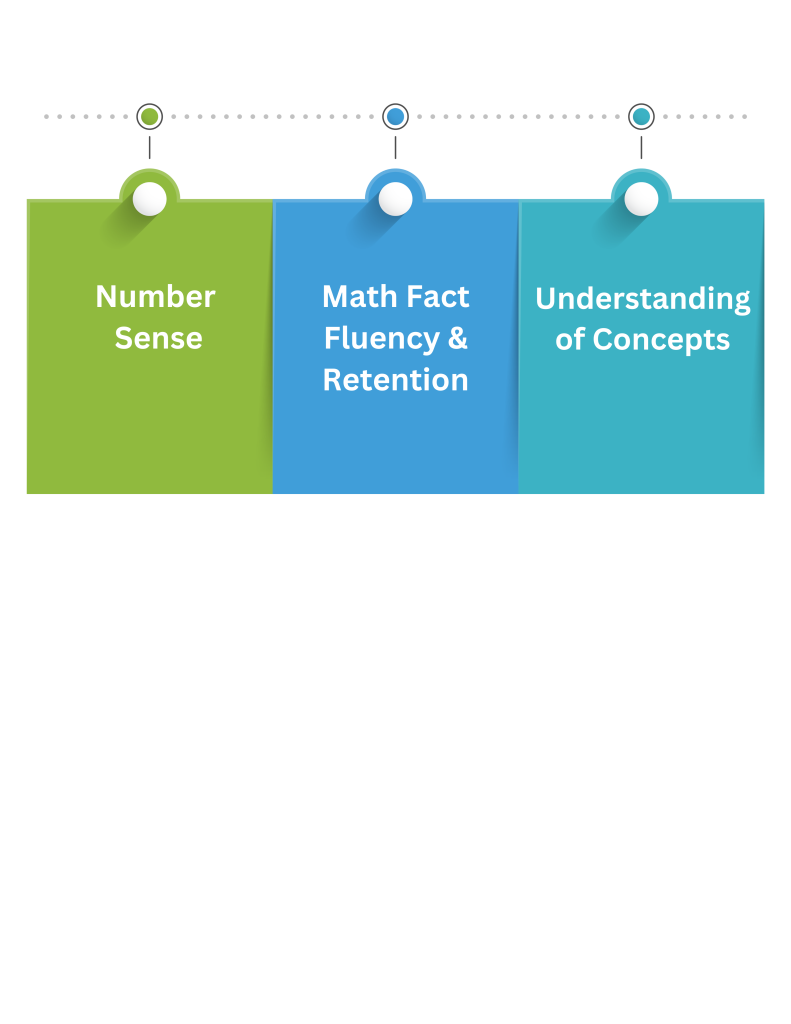One to One Educational Therapy for Dyscalculia & Math Anxiety
So often students get frustrated with math because the math task they are being asked to do assumes a mastery of underlying skills. For individuals with math struggles or dyscalculia, those underlying skills aren’t solidified yet. This can create a lot of stress around math.
- Difficulty understanding number sense (e.g., recognizing numbers, counting).
- Difficulty with retention and fluency of math facts (counting on fingers for addition & subtraction, difficulty memorizing multiplication and division facts)
- Difficulty understanding the meaning of operations (addition, subtraction, multiplication, division).
- Difficulty with word problems
- Difficulty with math-related tasks in everyday life (e.g., telling time, understanding measurements).
How It Works
1.
Initial Consultation on Zoom
Determine if my services are the right fit for you.
2.
Submit student work samples, educational assessment data, 504/IEP plan
Email correspondence and possible parent meeting
3.
First Student Meeting
We start with talking about interests and strengths to establish rapport.

Individualized sessions for dyscalculia begin with identifying the specific math skills the student needs to develop for their current academic demands, and the foundational skills that haven’t been mastered yet.
Sessions are tailored and scaffolded to build their thinking process about numbers.
During evaluation three primary areas are considered.

Specialized Approach for Multiplication and Division Math Facts
Students with dyscalculia can have difficulty holding onto their math facts. Sara teaches students to how to memorize multiplication & division facts by strengthening symbol imaging of numbers and incorporating learning style preferences. Symbol imaging skills allow students to mentally visualize and manipulate mathematical numbers so they can more easily recall math facts. In addition students develop an organizational system for retrieval of facts and math fact fluency.
Specialized Approach for Addition and Subtraction Facts
Students who struggle with subtraction facts and tend to count on their fingers have not yet developed the ability to use number relationships effectively for addition and subtraction. During sessions, students are taught how to think about and identify the different categories of addition and subtraction facts so they know how to approach each problem and which strategy to use.
Students learn important concepts like doubles plus one, and they learn how to use addition as a tool to solve subtraction problems. For students having difficulty memorizing math facts, the facts must be taught in a systematic and sequential manner. Many curriculums mix various types of facts too early, not allowing students with dyscalculia enough processing time to fully grasp and retain these concepts.
Specialized Approach for Number sense
Students who are counting on their fingers or having difficulty memorizing facts have usually not yet developed a strong number foundation of the quantity and relative value of numbers. During sessions students learn to internalize the hundred chart, and deepen their understanding of numbers through base ten blocks, ten frames, number lines, verbalizing their thought process and telling number stories.
Students with dyscalculia can need explicit instruction in number relationships to build meaning. Many curriculums move through these concepts too quickly for students with dyscalculia who need time and deeper explicit instruction to develop these concepts.
Math Anxiety
Many students have had negative experiences with math. Addressing stress around math is important aspect of strengthening math skills.
Learning can become more enjoyable. Sara is skilled at identifying what concepts students have already solidified and where they need to start their remediation.
Students often demonstrate less stress when the instruction meets the students where their skills are currently at, so that the learning feels attainable. Sessions incorporate interests, strengths, and preferred information processing styles with focus on:
- Providing a calm and supportive learning environment.
- Modeling positive self-talk and celebrating small successes.
- Gradually scaffolding the level of difficulty to build confidence.
- Working from concrete to abstract
- Multisensory learning
To support learning styles and develop an enjoyment of learning, students may:
- Use manipulatives
- Draw pictures
- Incorporate movement
- Use humor, and fun language & imagery
- Use visual references
- Play fun math games
- Reframe previous struggles
- Celebrate small wins
- Explain their thought process
Specialized instruction for Concepts
Sara’s Specialized Approach for Conceptual Development follows a Concrete to Abstract Progression
For individuals with dyscalculia, mastering mathematical concepts typically requires more than rote memorization. Students struggling with the meaning of operations at the abstract level need to build a stronger and more meaningful conceptual foundation.
Students who struggle with word problems and often resort to guessing can benefit from strengthening their understanding of underlying concepts, enabling them to apply the meaning of each mathematical operation more effectively.
Conceptual development moves from concrete to abstract.
Concrete learning refers to using physical objects, visual references, and manipulatives like base ten blocks to represent math concepts. Students use the objects to create a mental framework and understand the concepts.
Semi-concrete learning is when students begin to use visual representations, such as pictures or drawings, instead of physical objects.
Semi-abstract learning involves using simple number symbols with some visual aids but without full reliance on concrete objects.
Abstract learning involves using symbols and numbers to represent mathematical ideas without the need for tangible objects. Abstract learning is the most challenging.
The progression from concrete to abstract supports students building a deep, conceptual understanding of math.
Sara works with students on math skills up until high school geometry.
